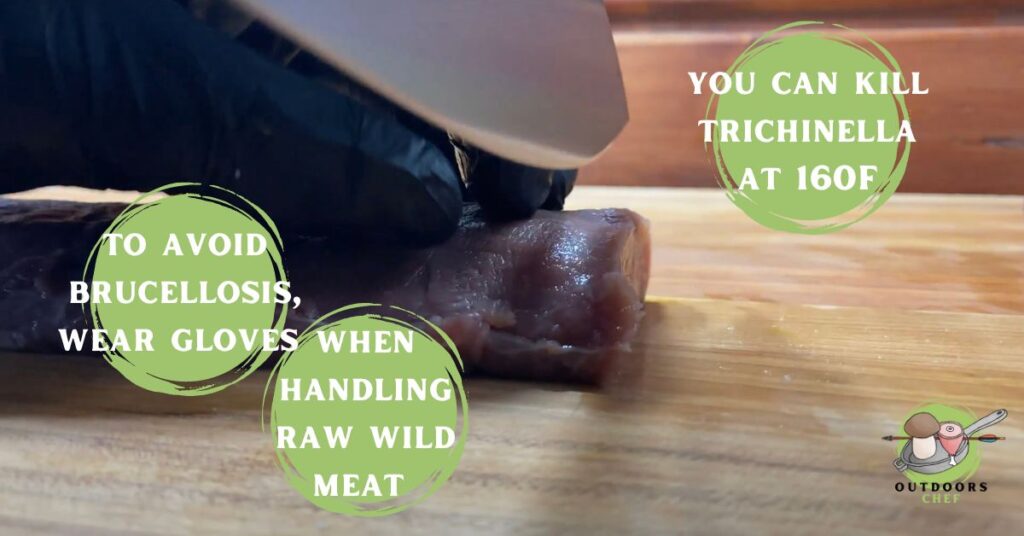The last thing I want to do is deter people from eating wild food; after all, I built this website to promote the benefits of wild food.
However, it’s not all rainbows and sunshine with wild food, which we will see in this article about wild hogs.
The most significant disadvantage of consuming wild boars is the increased risk of disease or illness, particularly trichinosis.
Dangers of Eating Wild Boar
Wild hogs get a bad rap, some of it unnecessary, and some of it deserved.
I am a proponent of eating wild boar. They are tasty and plentiful and wreak havoc on farmlands and wild terrain.
Whichever side of the fence you are on, I want to highlight some disadvantages of consuming wild boar, so you can understand both sides and make your own choice.
However, I want to make clear that most of the issues listed here are avoidable with proper handling.
Health Concerns

One of the main concerns with consuming wild boar is the increased risk of illness. However, this usually isn’t an issue can can be prevented through proper handling, and cooking techniques.
Trichinella
The most well-known disease caused by wild boars is trichinosis.
Wild boars, like bears, are omnivores, which means they consume meat and plant matter.
This means that also, like bears, wild boars can carry trichinella. However, there is no need for concern because you can kill trichinella by cooking the meat to 160F.
Brucellosis
A lesser-known disease that can be transmitted from handling or consuming wild boar meat is brucellosis.
Brucellosis is a bacterial disease carried by many wild and farmed animals, including wild boars.
The disease can be transmitted to humans through mucous membranes or open cuts.
This disease is rarely an issue when consuming meat and more of a concern when field dressing.
For this reason wearing proper gear and exercising precaution when field dressing or butchering wild hogs is advisable.
Flavor
Now that the main disadvantages of wild boar meat are out of the way, let’s look at some other things that some people may consider a disadvantage.
While for most, the flavor of wild boar meat is not a direct disadvantage, for others, it is.
Wild boar meat has a distinct taste and smell that can be likened to dirt.
In short wild boar tastes like dirt smells. I’m not talking about rubbish, but earth, the smell you get when you are digging up worms for fishing.
However, as with most wild game, the larger the animal, the stronger the flavor.
Wild boars that are old and large become particularly pungent, and the meat becomes tougher.
Sows are similar in toughness, but the flavor is a little milder.
Most wild hogs I hunt go one of two ways. Smaller hogs are used for delicate dishes that don’t require much seasoning, while larger boars are for dishes that are typically marinated or ground.
That said, if you make saucy dishes like wild boar curry or ribs, it doesn’t matter what size hog you use.
Cooking

Things can get a little tricky when cooking wild boar. Keeping in mind all that I mentioned above, one would be forgiven for being intimidated, but there is no need to be.
There are a bunch of recipes for wild boar on this site, and I will continuously add more recipes and cooking tips.
Still, cooking wild boar meat is more challenging than venison or other wild game.
First, you need to ensure that the meat is cooked to 160F. This means cooking rare or medium rare is off the table unless you are partial to taking great risks.
Next is the flavor, as we discussed above. If you have a 400-pound wild boar, the flavor might be a little strong for most.
You need to get creative with your recipes and limit your choices.
There are also other considerations when cooking. While most people reading this will be familiar with cooking venison and its limitations due to lack of fat, wild boar is even more challenging.
It’s true that most wild boars have a nominal amount of fat, but it’s also true no sane person with a working palate would want to eat it.
Cooking prime wild boar cuts are the most challenging; for cuts like osso buco or diced cuts, you can cook in moisture or make saucy dishes like ragu.
However, for the prime cuts, this would be a waste. The best dishes for these cuts will involve marinating or fast cooking, like schnitzel.
Final Thoughts
The disadvantages of wild boar are few, and the advantages far outweigh them.
You can enjoy some of the finest meat the wild has to offer with proper handling and proper cooking.









